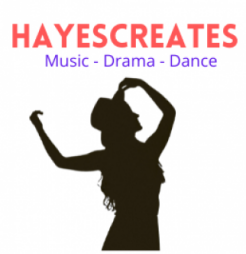Dance
Curriculum Intent
- To have uncompromising aspirations for every individual and for our school to be an exceptional and inspirational community of lifelong learners.
- To ensure all students have the knowledge to critically engage with the conversation of humankind.
Purpose
Dance at Hayes encourages students to be ‘Thinking dancers’ with the ability to use their skills of performance, choreography and appreciation of dance as life-long skills.
We aim to encourage students to build confidence in their own beliefs and opinions and give them opportunities to communicate these through their dance experiences.
Key Concepts that underpin the Dance Curriculum
- The art and process of Choreography
- Performance and Performing
- Critical Appreciation
- Historical and Social context
How does our curriculum shape learners?
As Hayes Learners, students will experience creativity, communication, reflection, independence and team work as key elements of every club, lesson and task within dance. Positive dance experiences raise students’ awareness of the importance of their own personal and social moral compass and the impact and influence on other people, working to build self-belief and confidence to take forward to future challenges in all aspects of their life.
| Academic end points | |
| Year 7 | By the end of Year 7 students will be able to perform within a group and demonstrate an ability to explore and communicate ideas through dance, using techniques that are an extension of their experience of dance at KS2. They will have acquired knowledge of the process of choreography using the key skills of Action, Space, Dynamics and Relationships. Students will use basic key words to express their own opinion on the work of others and can justify how their dance communicates a theme/idea or intention. Students will show social respect to other students as positive members of an audience. |
| Year 8 | By the end of Year 8 students will be develop their performance skills within a group and demonstrate an ability to explore and communicate ideas through dance, using techniques that are an extension of their experience of dance at Year 7. They will have developed their knowledge of the process of choreography using the key skills of Action, Space, Dynamics and Relationships. Students will develop consistent use of basic key words to express their own opinion on the work of others and can justify how their dance communicates a relevant theme/idea or intention. Students will show social respect to other students as positive members of an audience and understand how this expectation relates to the wider society. Students can recognise how their theme or idea relates to a social or historical context. |
| Year 9 | By the end of Year 9 students will be confident to perform within a group and demonstrate an ability to explore and communicate complex ideas through dance, using techniques that are an extension of their experience of dance at Year 7 & 8. They will have developed their knowledge of the process of choreography using the key skills of Action, Space, Dynamics and Relationships. Students will develop consistent use of key words to express their own opinion on the work of others and can justify how their dance communicates a relevant theme/idea or intention. Students will show social respect to other students as positive members of an audience and understand how this expectation relates to the wider society. Students can recognise and make clear connections as to how their theme or idea relates to a social or historical context. |
| Year 10 | Year 10 GCSE Dance students will be able to perform confidently within a group and as a soloist. They will demonstrate an ability to explore and communicate complex ideas through dance, using techniques that are an extension of their experiences at KS3. They will have clear knowledge of the process of choreography and will use vocabulary from the key words lists to express their own opinion on their own work and the work of others and can justify how dance communicates a relevant theme/idea or intention. Students will consistently show social respect to other students as positive members of an audience and understand how this expectation relates to the wider society and value the impact of this expectation. Students will have knowledge of all six of the ‘Anthology works’ and can recognise and make connections as to how their theme or idea relates to a social or historical context. |
| Year 11 | By the end of Year 11 GCSE Dance students perform confidently within a group and as a soloist in a formal performance environment. They will demonstrate an ability to explore and communicate complex ideas through dance, using techniques that are an extension of their experiences in Year 10. They will have choreographed their own solo/group piece for final assessment and demonstrate clear knowledge of the process of choreography using key vocabulary to express their own opinion on their own work. Students can confidently justify how dance communicates a relevant theme/idea or intention. Students will consistently show social respect to other students as positive members of an audience and understand how this expectation relates to the wider society and value the impact of this expectation. Students will have detailed knowledge of all six of the ‘Anthology works’ and can recognise and make insightful connections as to how their theme or idea relates to a social or historical context. |
| Year 12 | By the end of Year 12 students will have experienced performance in a range of styles and techniques, with a focus on Jazz, Ballet and Contemporary dance. Students will perform with expressive, technical and physical skills and communicate these within a particular style or genre. Students will explore more complex choreography using skills from KS3 & 4 to compose their own solo and group dance works expressing and communicating a range of themes, ideas or choreographic intentions. They will apply the complex process of choreography as an art form to a range of subject matter and intentions. Students will confidently appreciate the performance and choreographic craft of their own and others work. They will analyse and evaluate the overall performance of a range of professional works, the work of other students and their own compositions. Students will be able to write coherent and analytical essays in response to a range of questions on the areas of study and the set works. Their writing will consistently use key dance vocabulary and will include justification, evaluation and opinion. Within their practical and written work students will refer to relevant historical and social context and make comparisons, opinions and evaluative judgements based on these connections. |
| Year 13 | By the end of Year 13 students will be able to confidently perform in a range of styles and techniques, with a focus on Jazz, Ballet and Contemporary dance. Students will be able to articulately perform with expressive, technical and physical skills and communicate these within a particular style or genre. Students will compose their own solo and group dance works to express and communicate a range of themes, ideas or choreographic intentions. They will confidently apply the complex process of choreography as an art form to a range of subject matter and intentions. Students will have a self-assured approach to appreciating the performance and choreographic craft of their own and others work. They will analyse and evaluate the overall performance of a range of professional works, the work of other students and their own compositions. Students will be able to write coherent and analytical essays in response to a range of questions on the areas of study and the set works. Their writing will consistently use key dance vocabulary and will include complex justification, evaluation and opinion. Within their practical and written work students will refer to relevant historical and social context and make enlightening comparisons, opinions and evaluative judgements based on these connections. Overall, students will be confident ‘Thinking Dancers’. |
Key features of learning
Subject matter and topics are made relevant and interesting, highlighting the ever-changing nature of society and how this is reflected in creative and performing arts. Lessons allow students a chance to take the lead and work independently of the teacher, exploring their own ideas and opinions. The curriculum follows a logical and sequential transition from KS3 through to KS5 and allows the threshold concepts to be explored in fine detail from a knowledge-based and practical approach at KS3 to a more analytical and critical approach at GCSE and A Level.
Extra-curricular clubs are open to all year groups and the range of creative dances created in clubs are showcased at Dancefest and Chance 2 Dance performances. Theatre trips to live performances are a key feature of wider learning in the subject and we have strong links with The Royal Academy of Dance and their ‘Step Into Dance’ programme which offer opportunities for students to experience dance in the wider community.
What will you see in lessons?
Practical work is key to Dance at all Key Stages. At KS3 this is mostly small group or pair tasks, which are shared with the whole class and given feedback from the teacher and peers. At KS4 practical work develops over a half term period and is linked to one the six professional works from the ‘Anthology Works’ with a focus on either performance or choreography. In KS5 practical lessons often follow a student led research, workshop exploration and performance refinement project. These are based on Jazz or Contemporary dance styles.
At KS4 & 5 there are also theory lessons which focus on analysis of constituent features eg. style, genre, practitioners, characters, set, lighting, aural setting and costume design.
This supports student preparation and practice of short and long answer questions for their written examinations.
What evidence of learning will you see in Dance?
Practical work is at the heart of learning and so practical tasks and performances are consistent evidence of learning. This showcases the obvious performance skills, but they are also clear evidence of student confidence building throughout their learning journey.
KS3 practical work is mainly supported by discussion and peer feedback – this may be supported by written worksheets or verbal feedback. Assessment is recorded on PE assessment records for each activity, dance is assessed through ‘exploring and communicating ideas’ as the theme of learning.
At KS4 & 5 written folders are used regularly by students and show the breadth of knowledge acquired. This is supported by regular low stakes knowledge tests, topic assessments and longer answer questions.
What formative assessment will you see in Dance?
At KS3 verbal feedback from teacher and peer assessment in lessons is the most regular formative assessment.
At KS4 and 5 this is also the predominant formative assessment. Use of the AQA grading criteria are used for each area to measure progress and are kept in topic workbooks and folders, these are used with self, peer and teacher assessment.
What is the department currently reading and why?
Jazz Dance: A History of the Roots and Branches – A great summary of the context of Jazz dance (Essential for A level!)
Katherine Dunham: Dance and the African Diaspora – an inspirational woman, ahead of her time.


